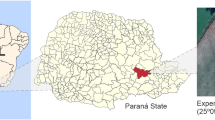Abstract
Deterioration of soil physical conditions occurs when rain or irrigation water displaces soluble salts during reclamation and subsequent management of salinesodic soils. Damage, which depends primarily on the presence of exchangeable Na+, appears to be ameliorated during leaching by exchange of Ca2+ and Mg2+ for Na+ and loss of exchangeable Na+ by hydrolysis. The extent of these processes has been measured by leaching columns of repacked soil with water after preparation with Na+ and Ca2+ or Na+ and Mg2+ as the exchangeable cations and high or low (1 or 0.1 molcl−1) initial salinities. Structural deterioration was monitored by changes in flow rate, and soil properties were measured both initially and after cutting the leached columns into layers. Preliminary studies established reliable methods for measuring exchangeable cations and cation exchange capacity in the saline soils. In a sandy loam (Na-Ca system), clay dispersion and movement occurred particularly in the upper layers as measured both by decreases in CEC and by the amount of clay in the leachate. Cation exchange and hydrolysis of exchangeable Na+ during leaching reduced the exchangeable Na+ percentage, although cation exchange was restricted to columns with high initial salinity. In a clay textured soil (Na-Ca system) there was negligible clay movement, and cation exchange and hydrolysis occurred in columns with both high and low initial salinities: cation exchange may have been encouraged by diffusion limited preferential release of Na+ from aggregates during by-pass flow. In the sandy loam (Na-Mg system) Mg2+ increased the preference of the soil for exchangeable Na+ compared to the Na-Ca system. There was no cation exchange even in columns with high initial salinity. The amounts of clay movement and hydrolysis were similar in the two systems. Conditions conductive to cation exchange are a high initial salinity, a Na-Ca rather than a Na-Mg system and, possibly, restricted release of the divalent cation from within soil aggregates. Attempts to model these changes are complicated by difficulties in predicting the effects of hydrolysis and by-pass flow.
Similar content being viewed by others
References
Churchman GJ, Skjemstad JO, Oades JM (1993) Influence of clay minerals and organic matter on effects of sodicity on soils. Aust J Soil Res 31:779–801
Chorum M, Rengasamy P, Murray RS (1994) Clay dispersion as influenced by pH and net particle charge in sodic soils. Aust J Soil Res 32:1243–1252
Curtin D, Steppuhn H, Selles F (1994) Effects of magnesium on cation selectivity and structural stability of sodic soils. Soil Sci Soc Am J 58:730–737
Emerson WW, Chi CL (1977) Exchangeable calcium, magnesium and sodium and the dispersion of illites in water. Aust J Soil Res 11:151–158
Jarvis RA (1968) Soils of the reading district. Soil Survey of England and Wales, Harpenden
Lebron I, Suarez DL, Alberto F (1994) Stability of calcareous saline-sodic soil during reclamation. Soil Sci Soc Am J 58:1753–1762
Marwan MM (1989) Changes in physical and chemical properties of saline-sodic soils during removal of salts by leaching with water. PhD Thesis, The University of Reading
Page AL (ed) (1982) Methods of soil analysis, Part I. Agronomy No 9. American Society of Agronomy, Madison
Pateras DT (1989) Diffusion, cation exchange and hydrolysis during the reclamation of a saline clay soil. PhD Thesis, The University of Reading
Rahman WA, Rowell DL (1979) The influence of magnesium in saline-sodic soils: a specific effect or aproblem of cation exchange? J Soil Sci 30:535–546
Rowell DL (1994) Soil science: methods and applications. Longmans, Harlow
Rowell DL (1985) The reduction in sodicity during the displacement of mixed CaCl2-NaCl salts from soils by water. Irrig Sci 6:11–18
Shainberg I, Rhoades JD, Prather RJ (1981) Effect of low electrolyte concentration on clay disperion and hydraulic conductivity of a sodic soil. Soil Sci Soc Am J 45:273–277
Skene TM, Oades JM (1995) The effects of sodium adsorption ratio and electrolyte concentration on water quality. Soil Sci 159:65–73
So HB, Aylmore LAG (1993) How do sodic soils behave? The effects of sodicity on physical behaviour. Aust J Soil Res 31:761–768
Stumm W, Morgan JJ (1981) Aquatic chemistry, 2nd edn. Wiley-Interscience, New York
Author information
Authors and Affiliations
Rights and permissions
About this article
Cite this article
Marwan, M.M., Rowell, D.L. Cation exchange, hydrolysis and clay movement during the displacement of saline solutions from soils by water. Irrig Sci 16, 81–87 (1995). https://doi.org/10.1007/BF00189164
Received:
Issue Date:
DOI: https://doi.org/10.1007/BF00189164




